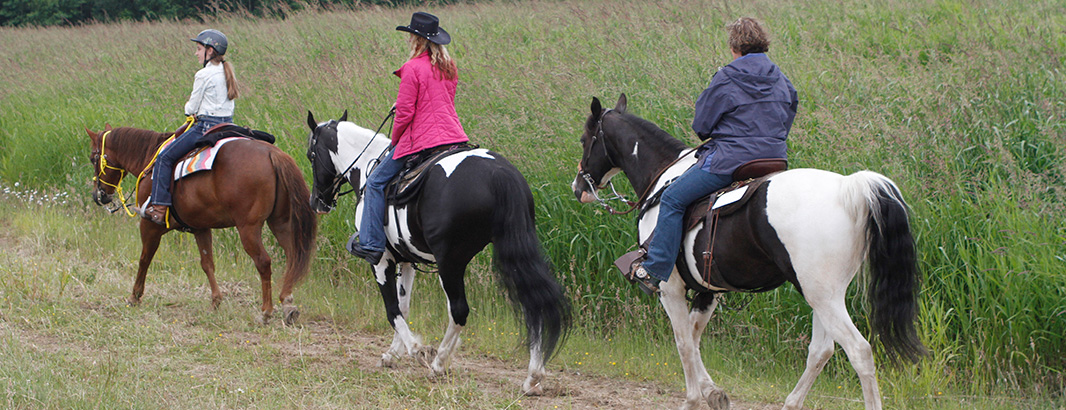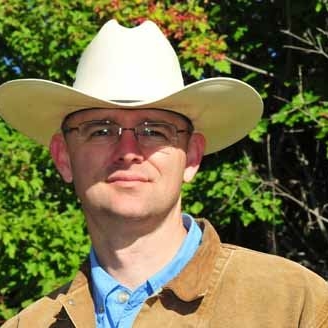Ten Tips to Ensure Safe and Happy Trail Riding
People often ask me why I’m a trail riding enthusiast. That’s easy. Horse trails are found in beautiful places— places with sunsets tinged with purple; snow-covered peaks piercing the horizon and skies so clear and blue they merge into black. On the trail one enjoys the sound of leaves rustling punctuated by the dull thud of hooves; the caress of heat, wind and cold; the warm smells of leather, horse hide and sweat. These elements fuel my passion by connecting me to a world of beauty where time disappears.

Another answer is more primal, but equally correct. I enjoy slowly becoming in tune with my mount during a trip and gaining a better understanding of the moods and temper of my horse. Other things I enjoy include brushing a soft coat before adjusting supple leather tack and the gentle rock of the saddle as you make your way down a path scented with pine. Every trail is unique with stunning displays that change at each bend, all framed by a horse’s ears.
Here in the Pacific Northwest we are blessed with many fabulous equine-friendly trails, all within a day’s drive. The Pacific coastline offers beach rides with gentle ocean breezes and, further inland, rainforest trails meander through tunnels of moss and ferns. The Cascade Range has horse trails of every type, as well as many excellent camps to base your rides out of. Not only that, the high desert of central Washington and Oregon offers open range riding through rolling hills of sage.
Since I ride probably 200 days a year (a fair number of those chasing the end of the trail across the western US) I am fortunate to have many wonderful memories. One that stands out is a summer trip a few years ago in Montana’s Bob Marshall Wilderness complex. It started in the inky blackness of the pre-dawn morning with the familiar rituals of grooming, feeding and watering at the Owl Creek Trailhead. On this trip I would be helping support a crew of wildlife biologists that would be monitoring the health of the native trout population. I was also an eager assistant to Andy and Chuck of the local Backcountry Horsemen Chapter. Those two are packers, in the truest sense of the word.
After leaving the trailhead we made our way to Upper Holland Lake, past spots on the trail composed of narrow steps of slick rock situated on near vertical mountain faces where one stirrup kisses the wall and the other dangles high above the last switchback in the trail. As I listened to the steady thudding of the horses’ hooves, I hoped my mount was having a good day! After seven days in 1.5 million acres of breathtaking wilderness, it was time to head back to the trailhead. Breaking camp is always done with some melancholy and our final day in “The Bob” was no exception. The last glimpse of the Pendant Creek cabin, slipping away into the distance as we rounded the first bend in the trail, still lingers in my mind.
Like any equestrian sport, trail riding has its own special set of guidelines and preparation. The following are my top ten tips to help ensure that you and your mount enjoy many beautiful trail experiences.
1. Whoa and go, turns and control at all gaits are a prerequisite for trail riding. You should have a mastery of these basic skills before you head out.
2. Prepare beforehand to desensitize your horse to scary situations. An arena is a safer environment to practice possible trail encounters.
3. Mind your manners by being courteous to hikers, bikers and other trail users.
4. Clean up after yourself. Don’t leave piles of manure behind at the trailhead; be a good ambassador for equestrians.
5. Plan your rides within your horse’s current fitness level.
6. Before you head out, always let someone know where you are going and when you expect to return.
7. Carry a cell phone, map and compass on your body, rather than in a saddlebag, in case you and your horse part company.
8. Keep your tack in good repair. You don’t want a broken cinch or bridle to ruin a ride.
9. Pack a basic first-aid kit for horses and humans.
10. Planning a trip? Many camping areas offer amenities to accommodate horses. You can find the world’s largest equine trail and camping guide at www.TrailMeister.com.
Photo courtesy of NW Horse Source Photography
Published in May 2015 Issue

Robert Eversole, ”the trail meister,” owns www.TrailMeister.com, the largest database of horse riding and camping areas in the U.S. with free trail and trailhead information, trail maps, and much more to help horse enthusiasts experience the joys of trail riding. Robert is a registered riding instructor with PATH International, a mounted search and rescue team member, and a U.S. Marine who has served on the board of the Backcountry Horsemen of Washington (BCHW). He is enjoying his new career helping fellow trail riders stay found and safe on the trail. When not on the trail, The Trail Meister resides near Spokane, WA and teaches land navigation to a wide variety of outdoor groups across the nation. For North America’s largest horse trail and camping directory, trail tips, and more, visit www.TrailMeister.com.





